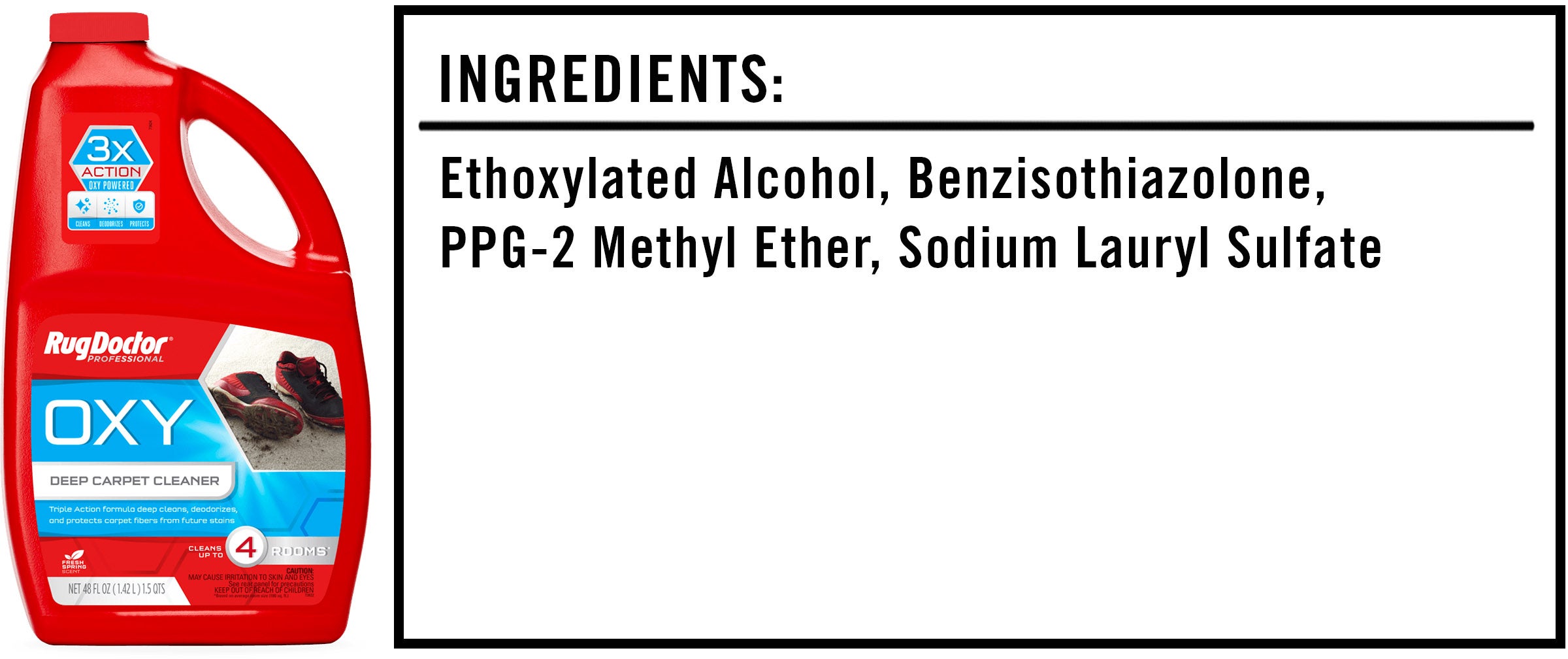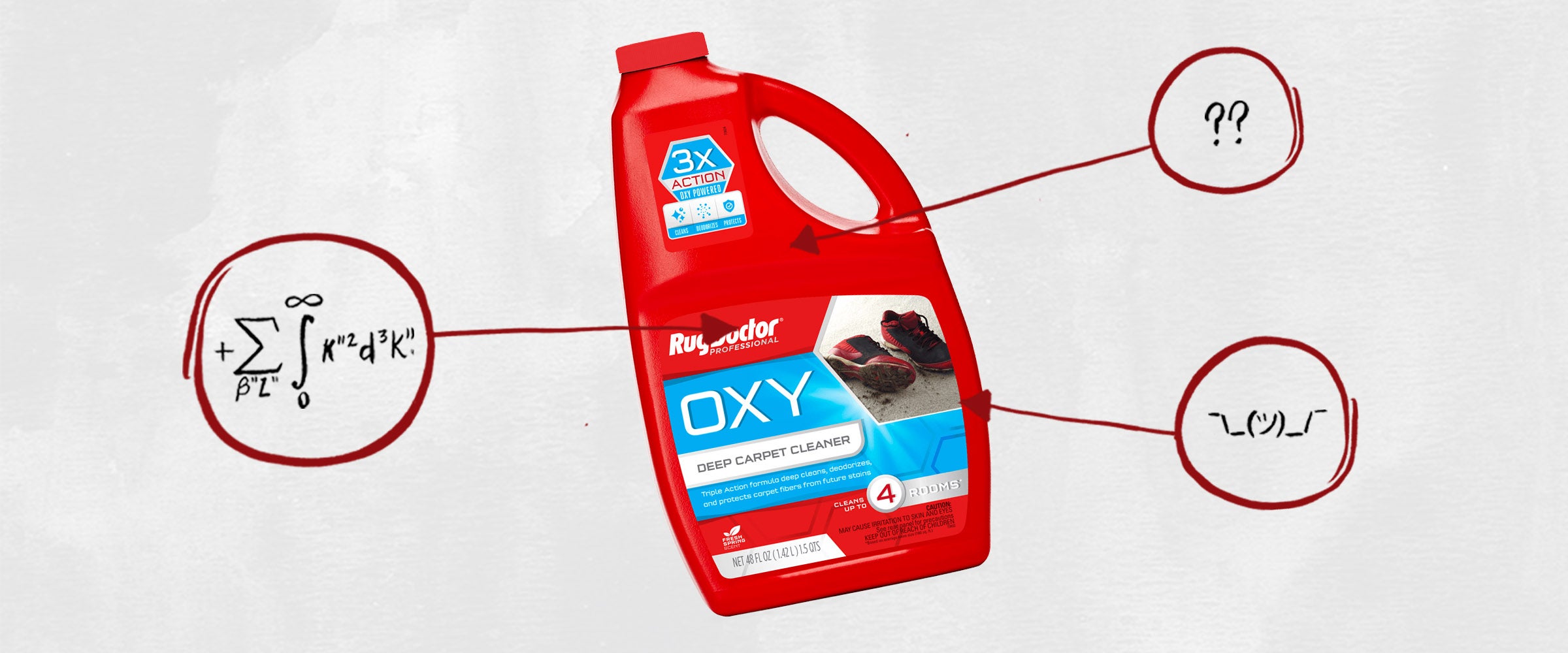We’re often told that you should never eat anything (or put anything on your body) if you don’t recognize everything on the ingredients list. But since most of us have no idea what xanthan gum or potassium benzoate are — or more importantly, what they’re doing to our bodies — we’re decoding the ingredients in the many things Americans put in (and on, or near) themselves.
This edition: Rug Doctor carpet cleaner, which is made from four (or more) separate ingredients that we’ve broken down in the exact order they appear on the Rug Doctor website.
Before plunging into the ingredients, though, a quick word about why there could be many, many more ingredients in this carpet cleaner than the manufacturer would lead you to believe: As we learned in our analysis of toilet drops, since cleaning products are definitely not intended for ingestion — as seen during the Tide Pod craze of 2017 — the FDA often allows them on the market without much regulation, which usually means no public ingredients lists. That said, the EPA still requires that cleaning-product producers list any active disinfectants or ingredients known to be potentially harmful, which could be why Rug Doctor designated a whole page on their website (where I pulled the following ingredients from) to reveal some of the more common ingredients in their products.
As for whether we should be concerned about the hidden ingredients because of this nonchalant approach by regulating agencies, some consumer advocates seem to think so. As Sloan Barnett, author of Green Goes with Everything, told Scientific American, “The government only requires companies to list ‘chemicals of known concern’ on their labels. The key word here is ‘known.’ The fact is that the government has no idea whether most of the chemicals used in everyday cleaning products are safe because it doesn’t test them, and it doesn’t require manufacturers to test them either.”
In other words, yeah, the government could probably do a better job of regulating the things we use around the house, especially as more and more science reveals that cleaning products are seriously damaging to humans.
With that, let’s get into the ingredients…

The Ingredients
1) Ethoxylated Alcohol: Ethoxylated alcohol is commonly found in laundry detergents, surface cleaners and cosmetics. It almost always works as a surfactant, which means it loosens dirt and other unpleasant deposits — like the wine that your friends will inevitably spill all over your home on New Year’s Eve — from your carpet so they can be easily rinsed away. Keep in mind, however, that most surfactants can irritate the eyes, skin and lungs. On their website, though, Rug Doctor claims, “Alcohol ethoxylates at the concentration found in Rug Doctor products are considered to have low to moderate toxicity if ingested and low toxicity for exposure to the skin.” Research also shows that ethoxylated alcohol isn’t carcinogenic, nor causes reproductive or developmental effects, which can’t be said for all cleaning products.
2) Benzisothiazolone: Benzisothiazolone is an antimicrobial and preservative chemical used in many cleaning products to prevent the growth of mold and bacteria. The EPA performed a review on benzisothiazolone in 2005, and they essentially found that it poses no significant harm to humans. However, they did find that it can be irritating to the skin and eyes, as other studies have found, and that it can be particularly harmful to aquatic life if it ends up in oceans and other bodies of water. So maybe look for a greener option if you care about the environment, which you definitely should.
3) PPG-2 Methyl Ether: This is a solvent that helps break up particularly oily and greasy stains that simpler surfactants might have trouble dealing with. Interestingly enough, PPG-2 methyl ether is also frequently used in cosmetics, and as one “final report” on the chemical concludes, “Overall the data are sufficient to conclude that PPG-2 methyl ether, PPG-3 methyl ether and PPG-2 methyl ether acetate are safe as used in cosmetics.” So you probably shouldn’t worry about this in your carpet cleaner, either.
4) Sodium Lauryl Sulfate: Another surfactant found in many strong household cleaners, sodium lauryl sulfate has a bad reputation for being too harsh. However, most research shows that it can be totally safe — even on your skin — when used briefly and rinsed away, although, once again, there’s some potential for mild to moderate irritation in sensitive-skin people.
The Takeaway
Again, we still don’t know the full range of ingredients used in this carpet cleaner, so we can’t really make a good judgment. But overall, it looks to contain the same things found in most cleaners: Namely, a bunch of surfactants that should be harmless so long as you don’t go washing yourself with carpet cleaner.
So go ahead and spill that wine. You know you want to…

